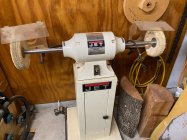joshb
Gold $$ Contributor
Aw, shucks! Made me feel all warm and fuzzy inside. Thanks for that! You’re doing a fine job and I watch your work to pick up some ideas!I dont have a scientific method of determining its denisty at the moment but so far it cuts like maple, a bit on the harder side.
I purchased this wood from a gentleman named Steve@Faroutfinds.com. Great guy and a pleasure to work with.
This is probably my 20th gunstock. Some have been failures or proof of concept and others were recieved well by folks.
I am not in the Houston Area. I am near Charlotte NC, I do not provide lessons, but no one has ever asked. I think @joshb has a spectacular thread that I have learned a lot from, I've contributed a little to that thread but Josh has done a great job outlining some steps that really help. You could also search my username and look up a thread I did a while back that outline some of my earlier procedures in my learning process.











